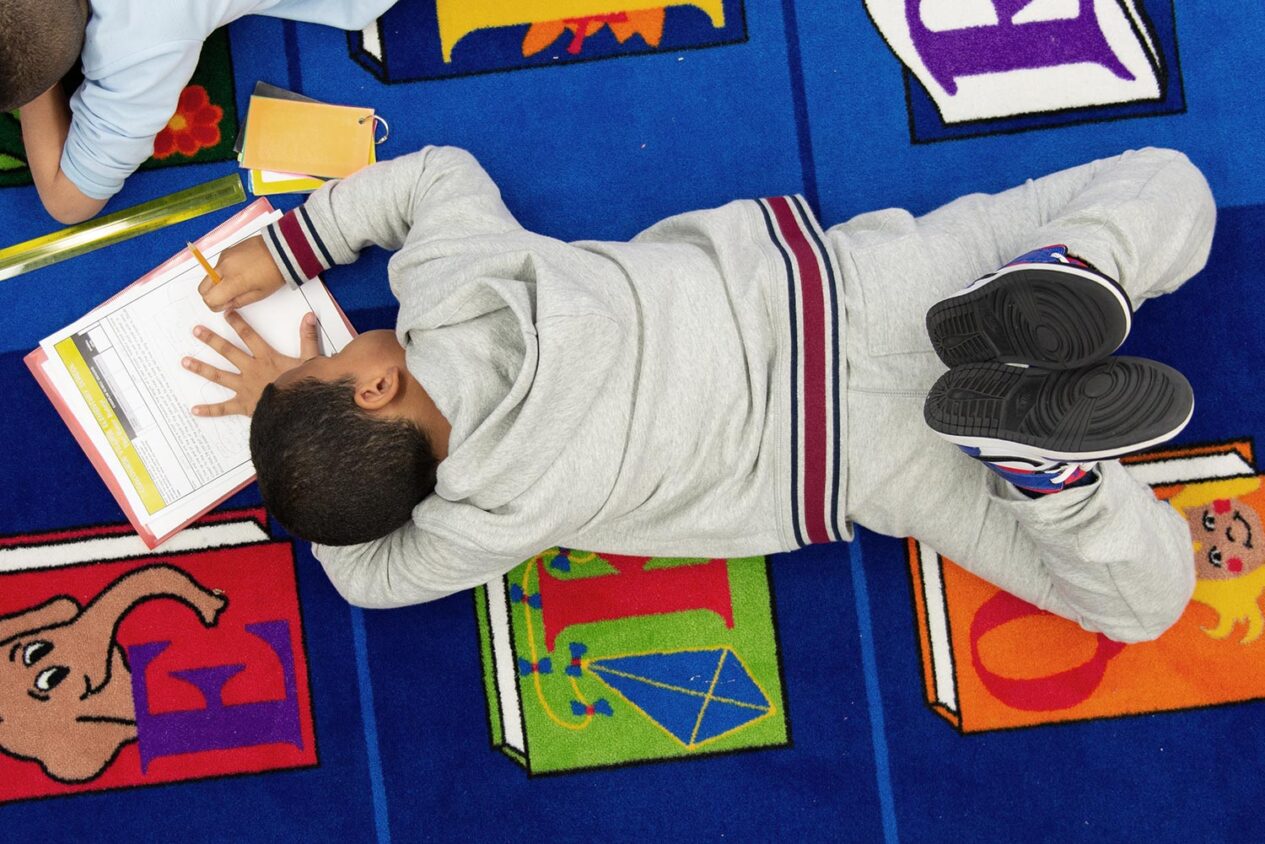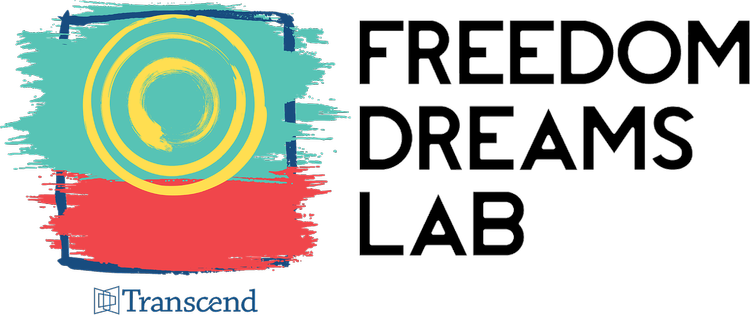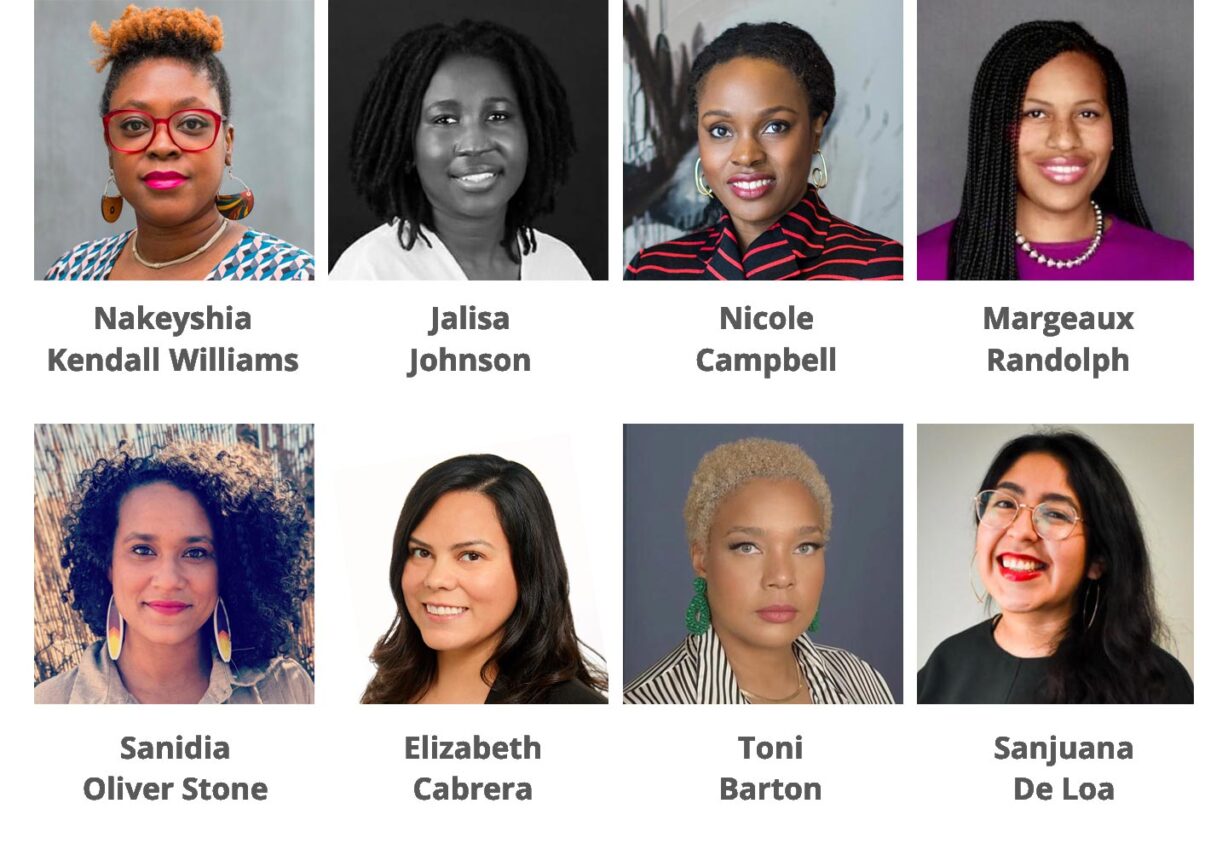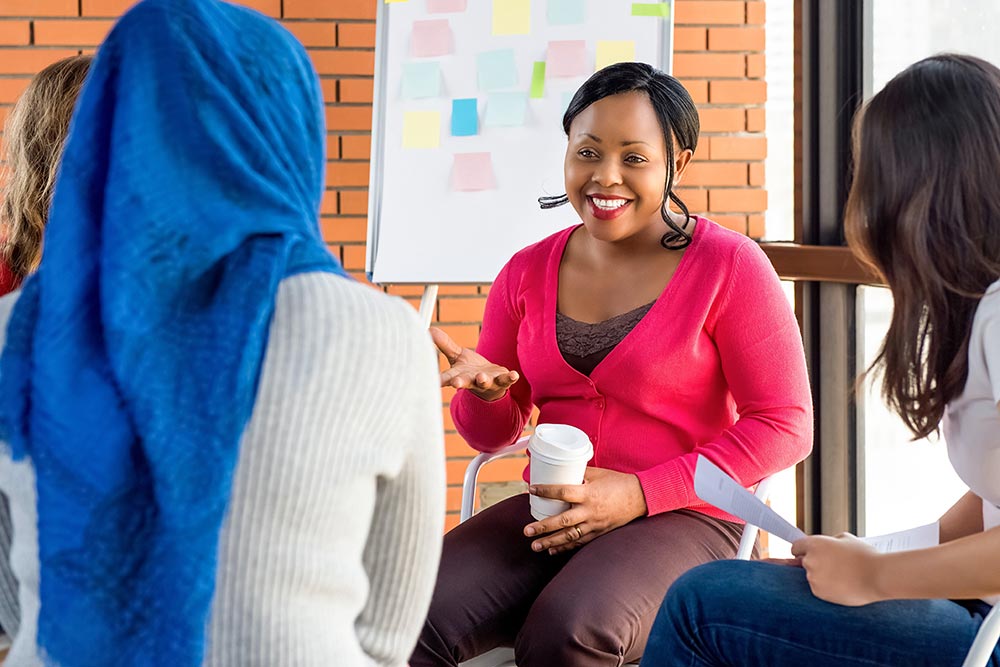Building Towards Possible: What We’ve Learned in the Freedom Dreams Lab

Dream with me for a moment: Picture a future where every child was in a learning environment that truly fostered their innate brilliance. What if those environments were in the minds and hearts of folks with firsthand experience of an obsolete status quo in education? Imagine what learning could look like if leaders bold enough to dream of this alternate future had the resources, time, and support to build school differently.
I’m Lyric Flood and I want to live in that world. I’m a son, a brother, a partner, a father to two beautiful Black children, an educator, a former school leader, coach, founder, and builder of possible futures. I believe education can be a tool that enables the status quo or one fosters the liberation of our nation’s young people.

In my work as a Design Partner at Transcend, a national nonprofit focused on reimagining school design, I have the privilege of shepherding the Freedom Dreams Lab (FDL) to live into our mission of supporting communities to build equitable, extraordinary learning environments. Freedom Dreams Lab is a year-long fellowship experience to strengthen the conditions Leaders of Color need to deepen their work, grow their capabilities, and advance their models’ actualization of extraordinary student outcomes within that alternate future.
Through its inaugural year, the FDL supported eight Female, Black, and Latinx leaders with powerful ideas, experiences, and expertise to design and develop learning environments that honor their communities’ needs and affirm and celebrate learners’ identities.

Despite calls for innovation, the same old approaches to designing learning environments are too often producing the same outcomes: school designs that reward rote thinking and compliance over creativity and critical thinking, and perpetuate disparities along racial and economic lines. We can’t expect things to be different if we are unwilling to do them differently. That’s why we created Freedom Dreams Lab—to design a different kind of fellowship experience for Leaders of Color who want to innovate and think beyond the status quo. We learn alongside those leaders surfacing powerful, new insights about how to best serve young people.
We intentionally created all aspects of the Freedom Dreams Lab to center and resource Black and Latinx Leaders, even the name itself. I was inspired by Robin D.G. Kelly’s book Freedom Dreams, where he writes:
“Too often, our standards for evaluating social movements pivot around whether or not they ‘succeeded’ in realizing their visions rather than on the merits or power of the visions themselves…And yet it is precisely these alternative visions and dreams that inspire new generations to struggle for change. Without new visions, we don’t know what to build, only what to knock down. We not only end up confused, rudderless, and cynical, but we forget that making a revolution is not a series of clever maneuvers and tactics, but a process that can and must transform us.”
Freedom Dreams Lab evokes this both in name and in spirit. Throughout history, education has been a tool for oppression, but it can be a tool for justice and liberation. We designed the Freedom Dreams Lab to give Leaders of Color a space to pursue their alternative visions and dreams that inspire new generations. Together, we are on a mission to build a new future.
A Different Kind of Fellowship Experience
We know that leaders most proximate to the problems their communities face—and the many assets their communities possess—are best equipped to develop solutions that prepare young people and their communities to thrive. Yet too often, leaders closest to the challenges they face are not given the resources to solve those problems. I was inspired to create the FDL because I saw an opportunity to bring to bear Transcend’s range of social, intellectual, and human capital to support Black and Latinx leaders’ brilliance and help make their visions a reality.
In our pilot year, the Freedom Dreams Lab offered three kinds of experiences to accelerate and actualize ideas from Leaders of Color for learning environments: co-conspiracy, community, and capacity.
- Co-conspiracy: Each Fellow had a “co-conspirator,” someone to serve as a collaborative coach, connect leaders to expertise and resources, and add capacity to help leaders address their evolving needs throughout their design journey. With this lens, the Lab paired each fellow with a co-conspirator who provided bespoke support that responded to leaders’ level, stage, personality, and aspirations.
- Community: During monthly meetings, we facilitated Fellows to gather and have conversations that only they could have: what does it mean to be a Black or Brown founder and entrepreneur? How do we navigate the challenges that come with fundraising, program design, and being Black, or Latinx, or women of color in this country at this time?
- Capacity: Throughout the FDL, Fellows connected with members of the Transcend network to gain access to real-time support such as fundraising advice, business development acumen, and knowledge of measurement and impact, in order to deepen their capacity to build effective and sustainable learning environments. We also connected Fellows to members of Transcend’s broader community, such as funders, schools, and talent.
These tools all helped Fellows more intentionally and powerfully build new possibilities for learning environments. When creating their own models, Fellows sought to curate hands-on experiences that honor students’ interests and voices.
Take Toni Barton. Toni has been working to make Spelligent Schools a learning environment that works for every student, regardless of their need. Across the world, many students with special needs are excluded from a robust school experience with a variety of peers because the environments are not designed with their needs in mind. Galvanized by a vision where learner variability does not predict student outcomes or segregate their experiences, Spelligent designs experiences that meet every student where they are while ensuring each educator has the preparation they need to nurture their students’ diversity. Rather than moving through the typical subjects like math and reading, she asked, what if every learner of all ages (kids and adults) entered the “school building” and everything— subjected, content, and learners with all needs—was integrated?

For example, Spelligent’s literacy and math weaves together science and social studies content and gives students opportunities to engage in multi-sensory activities with written, audio, visual, and hands-on approaches. Toni calls this vision authentic inclusivity.
Toni joined the FDL with intentions of opening a network of schools with this approach. Through conversations with her co-conspirator and learning from experts in the Transcend network, she realized she had something special that current schools could adapt and adopt. So Toni and her co-conspirator got to work codifying and enhancing Spelligent’s “signature experiences” so existing school communities can truly serve their learners with the highest of needs.
But what about a student’s trajectory after high school? Nicole Campbell built Ownership is the Future, which ensures that Black students graduate high school with the belief, knowledge, and proof that they are creators of generational wealth. That proof is a working business or organization built through students’ purpose identification, an investment portfolio, and a powerful network. Ownership is the Future began as an out-of-school program offering Black high school juniors opportunities to launch and invest in their own ventures in real-time. Nicole recognized that high school wasn’t setting young people up for the many routes they can take toward economic and personal self-determination, especially young Black children. She started Ownership is the Future to change that.
At Ownership, students spend months clarifying their passions into business plans and pitching them to “investor-mentors,” industry professionals that reflect their backgrounds and give their time, talents, and treasures towards refining student visions. Take, for instance, one student whose dream is a sliding-scale hair salon for Black women, giving access to affordable hair services and products in order to feel cared for, confident, and beautiful. Through the Ownership Is the Future course, this student (and every student) graduates with a $1,000 seed investment toward their venture, invaluable social capital, and new skill sets to pursue their ventures post-high school. The dream Nicole is bringing to life: that every Black high school graduate is an owner of a diploma in one hand, a wealth-building venture in the other hand, and a powerful mindset and network to lead choice-filled lives.
Nicole initially thought out-of-school time was the best fit for a program like this. After all, Nicole didn’t see high school as a place designed to cultivate young Black entrepreneurs. Her time in the FDL, especially working with her co-conspirator and workshopping ideas with some of my colleagues at Transcend, pushed her to think about how she can create an even more transformative program: by changing kids’ educational experiences within the school day. For the past year, we have been working together to refine her model, build partnerships in three states across five school districts, and tailor the Ownership is the Future experience to a semester-long credit-bearing course. I’m hopeful that more young Black people will have these kinds of opportunities.
These two stories, among many, illuminate the beauty of the Freedom Dreams Lab; fellows have the conditions they need to unlock brilliant approaches to learning for their communities.
What Have We Learned from the First Year of the FDL?
We called it Freedom Dreams Lab for a reason—it wasn’t just a support program or incubator, but was deliberately designed to address a learning agenda about innovation led by Black and Latinx leaders.
We set out to answer three specific questions:
- What patterns and trends did we see in the design choices that Fellows made in their innovations?
- What unique challenges did Fellows face in advancing innovative approaches to learning?
- What kinds of supports did they find most and least valuable in overcoming the challenges?
Working alongside each of our Fellows to bring their dreams of equitable learning environments to life for young people brought us three big insights grounded in these questions.
Insight #1: Fellows designed learning environments that make Leaps towards extraordinary, equitable learning by putting young people in the driver’s seat of their own learning, infusing real-world learning, and giving learners chances to tackle and solve problems they see in their communities.
Fellows saw a need to create experiences that look and feel different from the standard school models that underserve Black and Latinx learners and communities of color—experiences that bolster learners’ agency, interests, and goals instead of compliance and memorization. They prioritized these learning experiences.
The process of supporting and getting to know the eight women of color this year in the FDL illuminated that the learning environments they’ve conceived come from their lived experiences as students, caregivers, and educators themselves. While their experiences and ideas are deeply personal, they also represent an unacceptable shared reality for far too many communities in our country where the current schema of “school” has not adequately resourced and served young people for generations.
This is evident in Nicole’s freedom dream for Ownership is the Future: to equip high school graduates with the abilities, networks, and resources to build generational wealth sooner. For her, opportunity was left up to chance, but it doesn’t have to be; high school can be a place of realized promises. Our working theory is this: nurturing and honoring Fellows’ ability to tap into their lived experiences as they design innovative and equitable learning models unlocks both what new possibilities for learning can look like and how they can be built. This process will help them create transformative learning opportunities that fuel young people’s creativity and critical thinking—especially young people of color—so their education trajectories prepare them to prosper into adulthood.
Insight #2: Leaders of Color face profound felt and lived pressures at the intersections of race and gender when designing and leading innovative learning environments.
For example, two Fellows innovators are Latinx and first generation college graduates who are creating a learning environment for middle schoolers to grow as leaders and build campaigns for issues they care about. However, their time and resources are spread thin. As first generation leaders, they are also responsible for supporting family members who did not have the same opportunity, which impacts how they make financial decisions and how much time they have to volunteer towards building their own designs.
Other racial and gender dynamics impact leaders’ experiences, posing unique challenges for female leaders of color. One Fellow described that she feels a potential double standard as a Black female leader in a role where she is keenly aware that negative stereotypes can undermine her position as a leader, even if she were to make the same decisions that a white male leader would be lauded as steadfast and strong for making.
Even those who have access to networks, resources, and tools reported that discrimination and/or the potential threat of negative stereotyping can obstruct how they can achieve their goals.
This validated how important co-conspiracy and community are. I saw first-hand that access to a network of peers and co-conspirators that are both navigating racial and gender dynamics and that deeply understand the entrepreneur’s journey can give Black and Latinx leaders the supports they need to stay in this work for the long haul to create more and better experiences for young people.
Insight #3: The FDL connected Fellows to a variety of capital, including social, financial, human, and intellectual capital that accelerated leaders’ learning environments by helping Fellows in three key ways: a) refine their ideas; b) advance their designs; and c) develop more sustainable and actionable business models.
Refine their ideas: Earlier-stage leaders, those with initial ideas for learning environments and experiences, expressed that the FDL components—particularly support from their co-conspirators—helped them identify their target audience and distill the purpose and aims of the experiences they sought to provide. For example, two Fellows came to the FDL hoping to activate a sense of leadership in young people. With the guidance of their co-conspirator, they formed a more robust idea for a program that supports middle schoolers as emerging leaders and helps them use tools at their disposal like social media to create campaigns for important issues in their lives.
Advance their designs: Later-stage leaders, those hoping to advance aspects of their learning environments, utilized support from the FDL to systematize and codify signature experiences and design principles that accelerated their model designs. As one later-stage Fellow said, “I got concrete ideas around each element of my model like signature, core experiences, and graduate aims. If you ask me to tell you the key ingredients of my model, I can now respond to that question.” One co-conspirator asked a Fellow to audit and rank all of their signature experiences so they were able to tease out exactly how they want young people to spend their time. These kinds of activities helped Fellows make sure all aspects of their learning environments from learner experiences to adult norms deliberately align to their goals.
Develop more sustainable and actionable business models: Fellows with operational learning environments developed blueprints, pitch decks, or other knowledge products that enabled them to better articulate and advocate for their models and resources they need. Fellows used these materials to gain more funding, advocate for their rationale, and ensure stakeholders have a clear and cohesive understanding of their learning environments.

One surprising learning was that Fellows found the convenings least impactful. Our intention was to co-create the convening spaces with participants throughout the FDL journey; however, Fellows reported that they benefited from more tailored, on-demand support that they received from their co-conspirators and engaging with the Transcend network. Fellows described that fostering a sense of comradery is deeply meaningful, especially for Leaders of Color embarking on this work, but they benefited more from support that helped them directly tackle problems they encountered creating and running innovative learning environments. This leads me to believe that building a sense of community for Leaders of Color still has the potential to powerfully advance their designs and foster meaningful relationships if we tailor convenings to the leaders’ immediate needs. We’re excited to test out what we learned here and from the field in new ways to hold space for fellows to gather based on the nature of their designs, specific problems of practice, or targeted capacity building.

One big aha the FDL gave me: Don’t assume, ask. While the principle ‘Don’t assume, ask’ has manifested in my personal and professional leadership as a continuous practice, the FDL has emphasized that this should not just show up in how we treat each other, but it should be structurally baked into how we support and invest in leaders who know what their communities need most. Rather than assuming nonprofit and philanthropic institutions know what Leaders of Color will benefit from, we should ask them what they need and give them ample resources. The FDL demonstrated that connecting Black and Latinx Leaders to all kinds of capital catalyzes their ability to materialize learning environments, but what made it most powerful was that Fellows had access to a support system that they could leverage as they needed.
What’s Next?
This is just the start. Based on everything we learned, we’re refining the design of Freedom Dreams Lab. The first year of the FDL, we knew we had to do things differently. This year clarified how important and impactful it can be to connect Black and Latinx innovators with a range of capital and a platform to pursue their visions. Next year, the FDL is supporting another group of Leaders to build a better future, one learning environment and one amazing leader at a time. We’re excited to continue to invest in Leaders of Color and enrich our learnings about how to best support and cultivate their bold ideas. In this next iteration, we are focusing on a critical stage in the development of Fellows’ models: piloting learner experiences, learning, and codifying lessons we learn. Additionally, we will be raising funds to add a meaningful capital investment to further resource Fellows’ visions in order to remove barriers to access for Founders of Color. And to lean into our commitment to continuous learning, we’ll have our next learning agenda to surface insights from and with our Fellows.
Imagine how many more extraordinary learning environments we would see if more innovators and Leaders of Color had the resources to develop them. If you want to make these learning environments a reality, won’t you dream with us?
Lyric Flood is a Partner on the School Design Team at Transcend. Lyric is a father, husband, and learner, currently preparing his doctorate in Urban Leadership with a focus on imagining liberating college and career pathways for Black children. He’s also learning to center rest and unlearning internalized oppression. Some of his favorite ways to recharge are reading, connecting with loved ones, and music curation.
Lyric Flood is a Partner on the School Design Team at Transcend.

